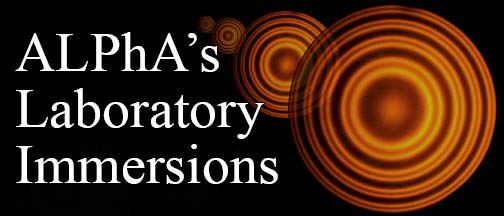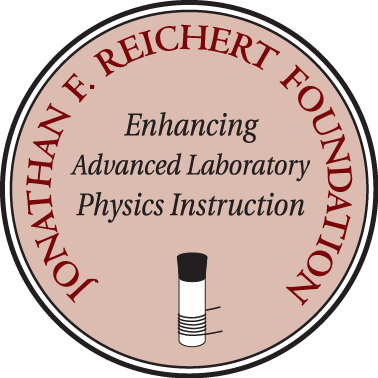- Home
- What We Do
- Laboratory Immersions
- Immersions 2024
- Imm2024Amherst_SoftMatter_Viscoelasticity
Univ. of Massachusetts - Amherst, Amherst MA
Soft Matter: Measuring Viscoelasticity
May 28, 2024 to May 29, 2024
Number of setups
available: 1
Maximum
number of participants: 3
------------------------------------------------------------------------------------------------------------------------------------------
Note: The UMass Soft Matter Summer Course follows this Immersion -- Participants will be able to also sign up for the undergraduate soft matter course that is happening May 29-31. This class is attended by undergraduates and faculty interested in learning more about soft matter and includes a tour of the soft matter research labs. Participants are encouraged to attend if they can.
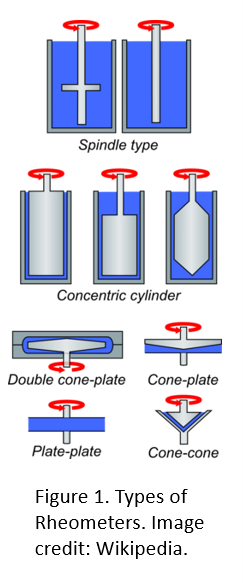
Soft Matter Immersion on Measuring Viscoelasticity. Participants can stay for the UMass Soft Matter Undergraduate Course May 29-31 or for the Graduate Course the following week on May.
Basic Physics – In high school, students learn that there are three states of matter—solids, liquids, and gases. Solids have a shape, while liquids and gases take on the shape of their container. Solids will deform when subjected to a shear force, often with an elastic response, which causes the solid to reform its original shape when the force is released. Liquids flow under a shear force with the rate of the flow given by the liquid’s viscosity. After the shear force is removed, the liquid does not return to its original shape. Soft matter physics is concerned with mixtures of solids and liquids, which will produce materials with both viscous and elastic properties. One classic soft matter experiment is to measure the viscoelasticity of a material.
Apparatus – Here we will measure viscoelasticity using two different methods: using a rheometer (Fig. 1), and measuring the Brownian motion of beads in the material using a microscope.
The rheometer is a classic instrument used in industry to measure the viscoelasticity of cosmetics, paint, gums, slurries, lotions, condiments, pastes, and many other food products. Typically, a rheometer consists of two plates, where the top plate is rotated relative to a bottom plate to produce a shear force (Fig. 1). The rheometer sets the strain rate of the top plate (the velocity of the top plate divided by the height between the plates) and measures the stress (shear force per area) to move the plate. However, rheometers are often expensive (Fig. 2, MCR-72 from Anton Parr is $20k).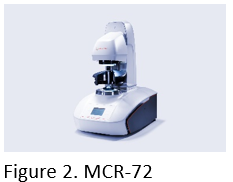
A cheaper, more practical experiment is to measure viscoelasticity using the Brownian motion of micron-sized beads suspended in a medium of interest (Fig. 3). Brownian motion is a popular experiment in the undergraduate lab and only requires a microscope and a camera.
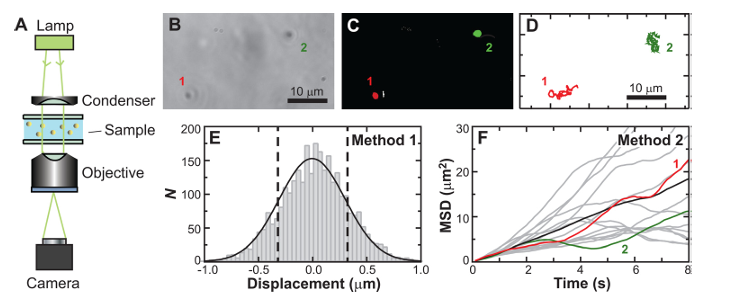
Fig. 3. Brownian Motion Experiment. A) Microscope to image a sample of micron-sized beads in a medium of interest. B) Image of beads. C) Threshold image to obtain the bead centroids. D) Track of the beads. E-F) Analyze the bead tracks by two different methods to obtain viscoelastic properties about the medium. (Figure from Catipovic et al. 2014 AJP.)
Importance – Soft matter physics is one of the fastest growing fields in physics. Researchers in this field look at the physical properties of polymers, colloids, surfactants, liquid crystals, and amphiphiles. They study self assembly, non-equilibrium dynamics, material activation, wetting, tension, and viscoelasticity. However, there are very few soft matter experiments in the undergraduate laboratory. The rheometer and the Brownian motion measurement are both classic soft matter experiments. The Brownian motion experiment is cheap and easy to implement.
Skills that will be acquired – Participants will learn viscoelastic theory, get to use a commercial grade rheometer to measure different properties (stress vs strain rate, thixotropy, yield point determination, sagging or leveling behavior), and compare these rheometer measurements to the viscoelastic measurements obtained via Brownian motion. Participants can stay for the University of Massachusetts School on Soft Matter, which occurs right after the Immersion.
Outline of the two day Immersion:
Day 1 (Morning) - go over mathematical theory for measuring viscoelasticity and complete some simple problems to calculate G’ and G’’.
Day 1 (Afternoon) – take measurements with the rheometer and use software to generate plots, extract G’ and G’’ from the data.
Day 2 (Morning) – take measurements on the same materials by measuring the Brownian motion of particles, and extract G’ and G’’. How does this measurement compare to the rheometer?
Day 2 (Afternoon) – finish taking any measurements and time to explore any of the other experiments at the Immersion.
Participants will benefit from bringing their own computers since they can download all of the free software from the internet and will be able to implement the calculations.
Safety considerations – General lab safety procedures will need to be followed. Clothing should be closed toed shoes, pants or long skirts, and long sleeves.
Cost estimate for the equipment – Rheometers are expensive ($20k), while Brownian motion experiments (microscope plus camera) are typically already found on many college campuses. Brownian motion experiments could be extremely cheap with webcams ($30), 40x objective ($100), and some Thorlabs parts to make a microscope ($400). We will be performing a Brownian Motion Experiment on a research grade microscope ($30k) and Coolsnap Ez camera ($5k).
Travel information
Flight
Closest airport is Bradley (BDL) in Connecticut, but another choice is Boston (BOS). Usually people book ride-share shuttles to get from the airports to UMass. More information is at: https://www.cics.umass.edu/grads/arriving-amherst
Hotel
For accommodations, we have a special rate at the UMass campus hotel. Use this link to reserve a room ($179 a night).
https://www.reseze.net/servlet/SendPage?hotelid=1760&skipfirstpage=true&page=821421
This is right on campus and is within walking distance to the Immersion site. You also get free parking in the parking garage that is connected to the hotel so it makes everything very easy. Another choice is to use one of the area hotels, but then you will need transportation to UMass (bus or car).
Parking
If you will have a car, then parking in the garage is $1.75 per hour, lot parking is $8 per day.
https://www.umass.edu/transportation/summer-permits-2024
Public Transit
If you will be using the UMass bus system, then the UMass buses are free.
Host and Mentor:
Please note that the Jonathan F. Reichert Foundation has established a grant program
to help purchase apparatus used in Laboratory Immersions. Limitations
and exclusions apply, but generally speaking the Foundation may support
up to 50% of the cost of the required equipment.

